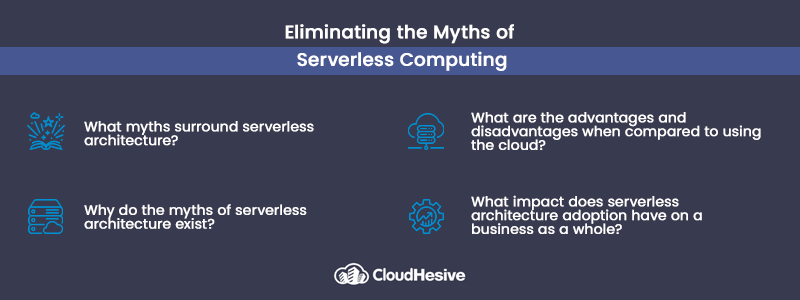There are quite a few myths surrounding the topic of serverless computing, and although it may be a new concept to some, the benefits it provides are substantial to cost savings, increased agility, and more. We eliminate the myths to leave only the actionable truths.

Serverless computing is much more beneficial than you might think, as it doesn’t require the management costs that go into managing servers and on-demand cloud services. Although more enterprise businesses are starting to understand how serverless computing can help support their daily operations, widespread adoption is still relatively far away.
Most of this concerns the myths surrounding serverless architecture, as it’s a topic that many people haven’t fully grasped yet. Serverless computing can do much more than minimize infrastructure management costs, as it can offer a level of efficiency not found anywhere else.
With the help of this technology, organizations can optimize code execution time, run code without provisioning, and streamline the complex nature of traditional systems. To properly use it to your advantage, you’ll first want to clear away the myths of serverless computing and how the technology functions as a whole.
What are the myths surrounding serverless architecture?
There are several misconceptions regarding serverless computing, many of which stem from a simple lack of education on the matter. However, it’s understandable to ask questions when it comes to new concepts, especially when it comes to technology. It can be a fairly convoluted topic, but debunking common myths will set a clear path to a newfound understanding of why serverless computing may be right for your business.
1. Serverless computing is expensive
This is far from the truth, as serverless computing can significantly reduce costs compared to traditional infrastructure management models. In the same vein, serverless could potentially be more expensive when working with domains and services that aren’t optimal for how it functions. You must be sure it fits your needs.
Serverless computing runs off a pay-per-use cost model, which is inherently cheaper than the ongoing costs of traditional infrastructure. Considering its cost model, you can see how it could save you money based on how it processes requests. This goes hand in hand with serverless computing’s scalability and elasticity for organizations.
2. Serverless computing doesn’t offer optimal performance
Some believe that serverless computing entails longer API response times, but this simply isn’t the case. It’s a highly adaptable technology able to serve a business’s operations on multiple levels. Serverless delivers faster execution speeds when compared to traditional models. It should also be mentioned that some aspects of speed pertain to the complexity of a function related to a certain process.
3. Serverless computing lacks security
This myth is easy to break down as serverless computing is a highly secured and PCI-compliant technology. It’s comparable to other standard cloud-based solutions, and organizations won’t have any trouble keeping their most sensitive information secure. Even if using a shared infrastructure, serverless computing provides businesses with the security they need, erasing the notion that this is a weak point.
4. Management of serverless computing is complex
Many people worry that serverless computing doesn’t offer needed support for application development and management. This isn’t true, as serverless functions come with many supported coding languages such as Python, Java, and more. You’ll also find that tools such as Kibana and New Relic make it easy to deploy and manage serverless-based applications.
5. Vendor lock-in
Other serverless myths include the assumption of vendor lock-in, as many people are used to the managed serverless environments that come from cloud service providers. Thanks to platform-agnostic frameworks, organizations can utilize independent code for specific vendors, providing a flexible serverless architecture to work with. If you’re looking for the utmost flexibility, serverless architecture is unbeatable.
This simply comes down to various misconceptions, which is somewhat understandable as organizations are still combating the learning curve of cloud-based services. With proper education and implementation, organizations will be better suited to migrate toward serverless architecture.
Although the adoption of this technology is becoming more widespread, many businesses haven’t considered it an option due to the workload that comes with migrating from one system to another. Nevertheless, it’s equally important to review the pros and cons of serverless computing compared to cloud services.
How does it compare to the cloud?
Serverless computing is known to be much more adaptable and flexible than other solutions. Cloud services are incredibly popular but can cater to specific use cases. For example, Amazon Web Services (AWS) Lambda focuses on a specific class of computing environments. You shouldn’t use these types of services to solve problems not relevant to your business – this could potentially lead to additional costs.
If a business were to implement a solution that is overly specific to its needs, it could make your infrastructure more challenging to maintain, use, and scale. Services like AWS Lambda don’t aim to deliver an all-encompassing approach to your infrastructure. Still, serverless computing delivers a unique, multi-faceted service that could very well be the solution you’re looking for.
How does serverless adoption impact a business as a whole?
One of the biggest selling points of serverless computing for a business is lower costs and increased agility and flexibility regarding infrastructure management. You can execute a vast range of business functions at a fraction of the cost due to the pay-per-use cost model of serverless computing. Before you can use this technology to your advantage, you’ll have to go through the migration process.
It’s optimal to be as proactive as possible when utilizing serverless computing, and early-stage migration will set your business on the right track. This also benefits teams focusing on application development, as they won’t have to manage or configure backend processes or physical servers. If you’d like to take a look into how serverless computing can support a wide range of business processes and functions, you can find numerous case studies on our website that dive into the viability and use cases of this technology.



